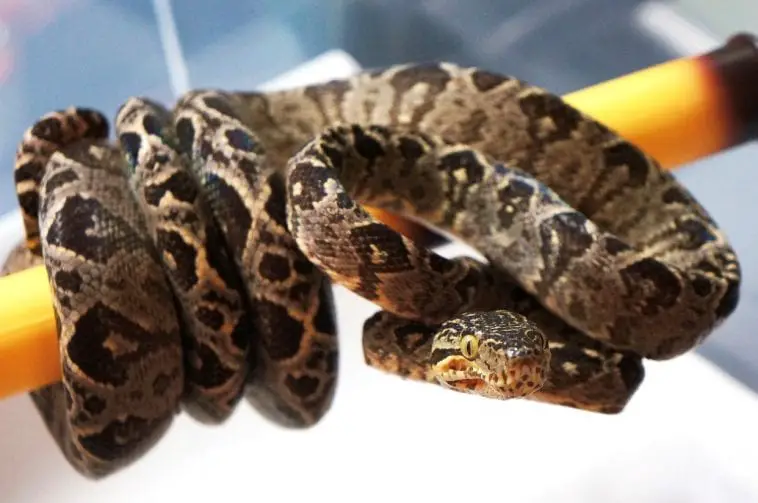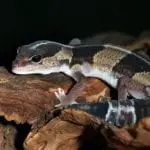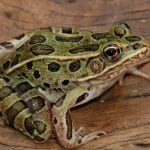Scientific Facts
| Common Name | Amazon Tree Boa, Common Tree Boa, GardenTree Boa, Macabrel, Cook’s Tree Boa |
| Scientific Name | Corallushortulanus |
| Life Span | 12 to 20 years |
| Care Level | Intermediate |
| Length | Up to 6 feet |
| Habitat | Rainforests and fruit orchards |
| Country of Origin | Brazil, Columbia, French Guiana, Guyana,Peru, Surinam, Venezuela, and most of the Amazonian River Territory |
Physical Description
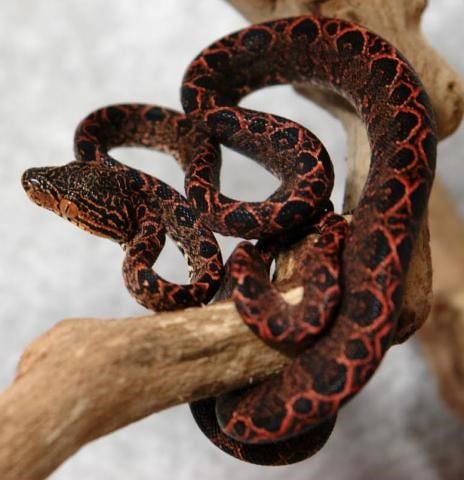
The Amazon Tree Boas are known for their beautiful and immensely varying patterns and colors. Usually, these colors range from red, brown, black, orange, gray, yellow, and many other colors in between. There are tree boas that are banded, saddled, speckled, chevron-shaped, and rhomboid-shaped, but they can carry no sort of pattern at all.
Basically, these snakes encounter two types of color phases. They go through the garden phase and the colored phase. When they are in the garden phase, they have a neutral and drab coloration, which tend to be olive green and brown with different patterns. Some experts state that this has an “oil on water” iridescence, especially when spotted with light. Once they are in the colored phase, these snakes come with a combination of yellow, red, and orange.
When they are fully grown, these amazon tree boas measure about 1.5 meters or 5 to 6 feet. In terms of girth, they are very thin, though, so their size is not too obvious when they are found balled up on the forest floor. Their slender bodies are partnered with large eyes placed in their broadheads. They use their large eyes are very useful for spotting these Amazon Tree Boas because they possess a characteristic called “eyeshine,” which means the light’s reflection within the pupil that glows a bright red in the darkness.
Aside from their unique eyeshine, they are also characterized by another thing of beauty – heat-sensing pits. Their supralabial pits detect heat similarly to how a pit viper would, which powers the boa its ability to see better during the night when it is most active.
Conservation Status
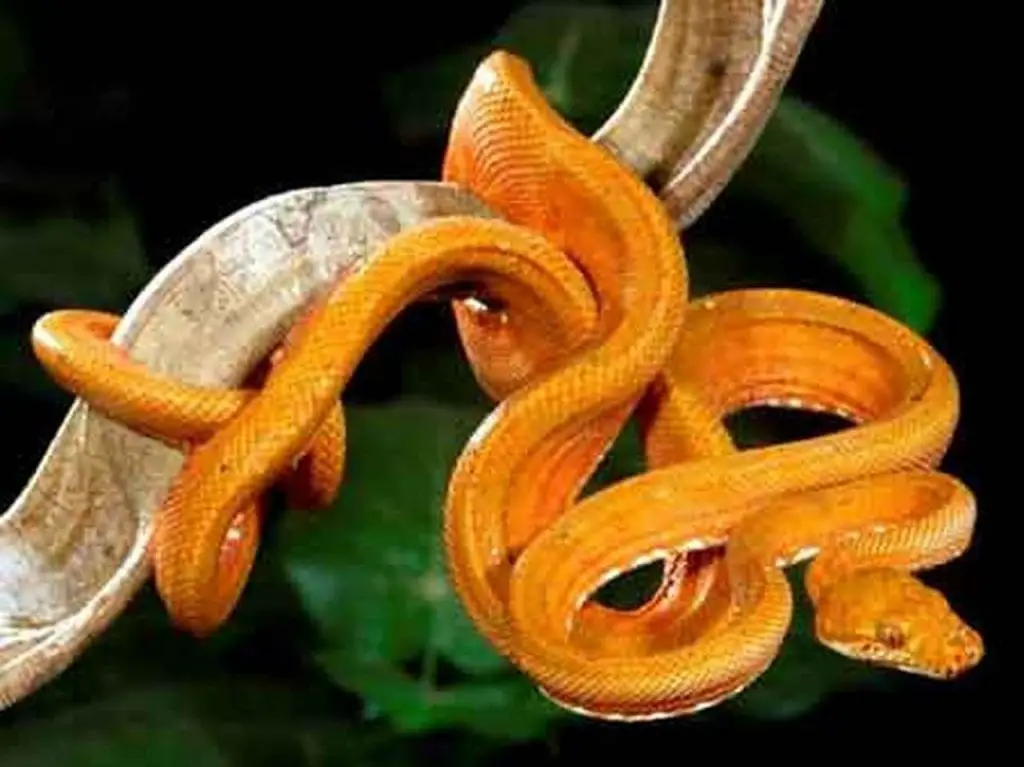
Amazon Tree Boas are listed as species of the Least Concern for population threats according to the IUCN Red List. This is based on their very expansive distribution, which includes protected sanctuaries, in the wild, and the homes of many breeders and keepers that take care of them.
Of course, their species still face threats locally. They are also affected by deforestation, as they spend a large part of their time upon the trees. There can also be human mistakes that threaten their lives, which is mainly misidentifying them as pit vipers and venom viper species.
Life Span
Though records of longevity for this species is not available in most related literature, it has been known that the average lifespan of most Amazon Tree Boas are about 20 years when they are raised in captivity.
Availability and Natural Habitat
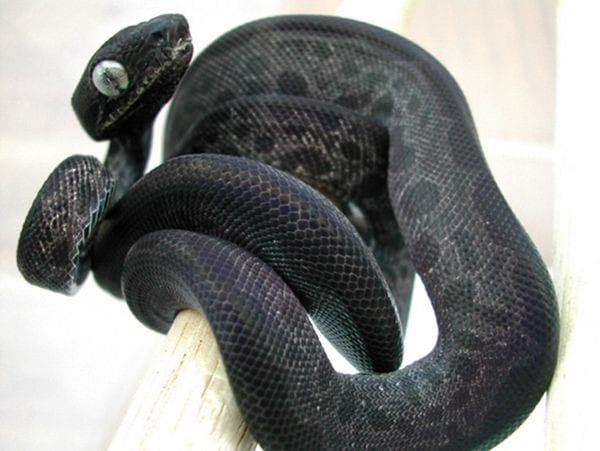
Most Amazon Tree Boas reside on the territories of Amazonia, Southeastern Brazil, Guianas, Southern Central America, Trinidad and Tobago, Venezuela, Colombia, and the Windward Islands. They can also be found in a wide variety of habitats. Most species prefer to stay in arboreal regions where there are high humidity levels. They also enjoy staying in dry areas of the forests as well as savannas.
Behavior
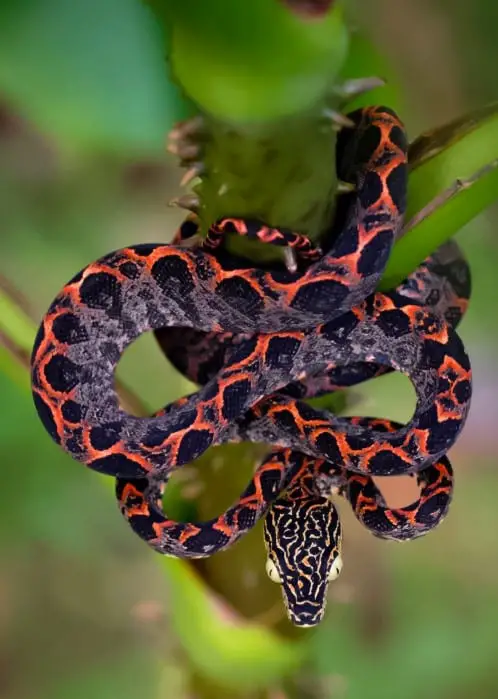
The Amazon Tree Boa can be very aggressive, and this is one of their most important qualities. They can still be hand-tamed, though, but it would take a lot of effort from the grower and a few sustained wounds to make your snake have the best behavior.
These snakes have long teeth compared to their head size, and they have a tendency to strike when they detect sudden movement. Because of this, they can keep on striking their enclosure and end up hurting themselves. This is why the experts suggest that these snakes be kept by expert keepers as novices might find it harder to interact with aggressive snakes.
When these snakes are very aggravated, they also whip their tails and produce a musk that is very foul-smelling. This scent will be difficult to remove, similar to how a skunk’s defense mechanism would be.
Snake keepers must also beware of the aggressive tendencies that become worse during the night. As they are naturally nighttime hunters, they exhibit food aggression and attacking behaviors at this time. They may mistake the keeper’s warm hands for their prey items and elicit a painful, though non-venomous bite. They might also strike and constrict your hands, especially if they are feeling very agitated.
Diet
On their natural habitats, Amazon Tree Boas eat lizards and frogs. But during captivity, they are often fed with rodents like mice. Juveniles can be fed every 5 to 7 days, while adults can be fed every 1 to 2 weeks. Being overweight can be unhealthy for these snakes, so their weight should be monitored very closely at all times.
Eating Habits
The Amazon Tree Boas are known for their great feeding response. They actually strike and grab the prey from where they are perched on a tree, and they wrap the prey as they pull them in. As an owner, watching your pet snake eat their meal while wrapped around the branch is both intriguing and satisfying, which is why no owner should miss witnessing this activity.
For Amazon Tree Boas in captivity, the suggested prey meal item is frozen then thawed mice. These are available all over the internet, and they do not have the means to harm the snake physically, in comparison to living rodents as prey. Because of their long and slender built, the Amazon Tree Boas must be introduced with multiple prey items before attempting to move up another size so that the snake will not be distended in an uncomfortable and unhealthy position.
For any kind of snake, the rule of thumb is to give them prey items that are not more than 150 percent of the size of their bodies. If you notice your Amazon Tree Boas are not responsive to taking mice as their meals, you can find them their natural prey items and scent the mice with them before feeding.
Mating, Development, and Reproduction
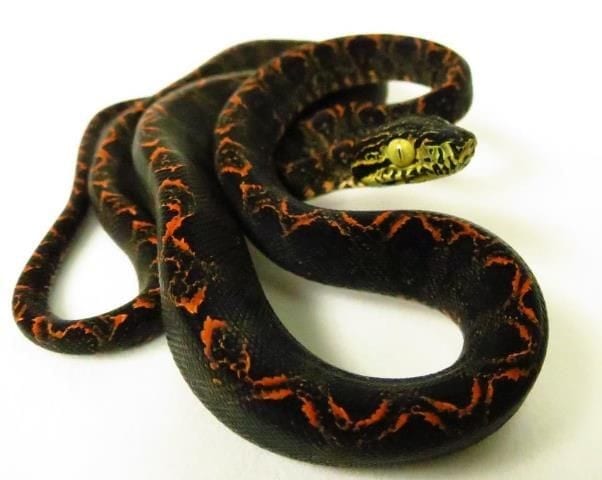
Breeding Amazon Tree Boas in captivity is much easier compared to breeding other species of snakes. These pet snakes are good options for entry-level breeders who want to learn more about breeding practices. For this species, breeding usually begins in the colder months of the winter, and this is usually instigated by the dropping of temperatures to about 9 degrees Fahrenheit or 5 degrees Celsius. Manipulating temperatures is also usually partnered with dropping the photoperiod to about 8 to 10 hours.
After the male and female snake is introduced, the males start courtship and breeding happens shortly after. The male should be allowed to breed the female multiple times just to make sure that the odds are high enough to assure pregnancy. The breeding period can last from a few days and last up to a month. Owners should introduce the male snake to the female daily until they lose interest with each other.
Once the female snake gets pregnant, she will need to have her enclosure temperatures raised so that the proper gestation will be observed. Owners should help with this matter by closely monitoring the humidity and temperature levels in the enclosure. Depending on the individual, a pregnant female might choose not to feed at all, but attempts to offer meals must be made every two weeks.
The entire gestation process will be completed for more or less six months, and they can be quickly identified by being so large that they almost pop when they give birth. Up to twelve babies Amazon Tree Boas are usually given birth to at a time, and they should be inspected upon birth for possible defects before being cared for separately.
Common Health Problems
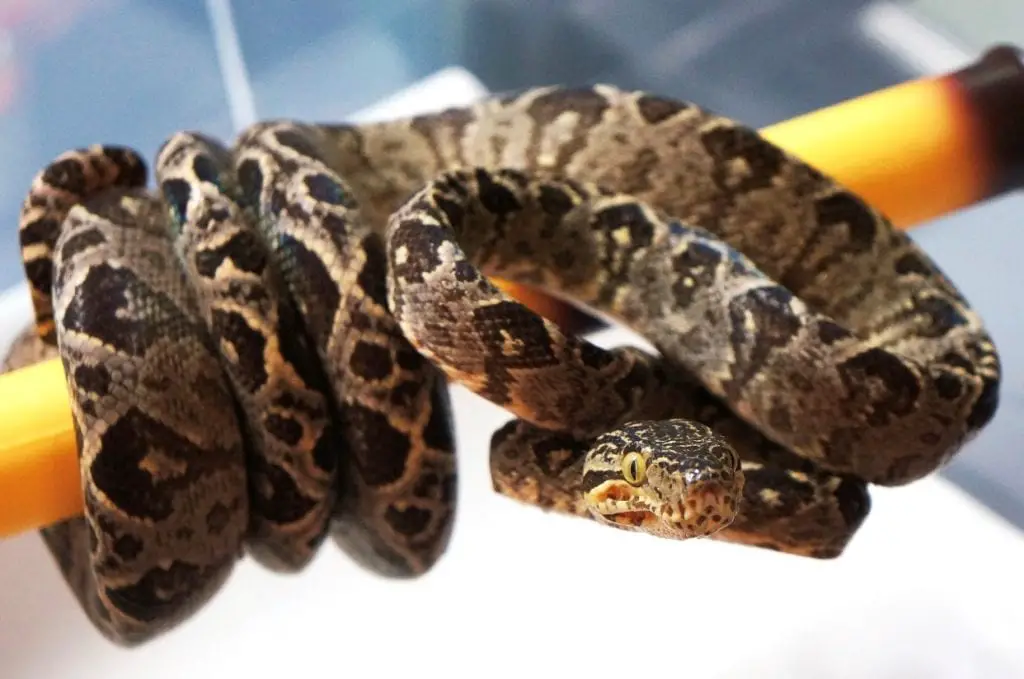
The usual health concerns that snake keepers must watch out for are:
Digestive
Snakes commonly encounter gastrointestinal problems like anorexia, constipation, diarrhea, and regurgitation, especially if they traveled far before reaching their new homes. If they are imported, they might also have anorexia brought up by parasitic infections. Constipation, on the other hand, can be caused by dehydration since the snake has to absorb more water just to stay hydrated, and their feces dry out, which makes it much harder for them to pass. Constipation can also be caused by overfeeding your pet Amazon Tree Boa. Also, when stressed, snakes may not feel interested in eating, which can lead to further illness.
Respiratory
Because of humidity problems and extremely low or fluctuating temperatures, Amazon Tree Boas can develop infections on their respiratory system. The signs can include excessive mucus on their mouths, labored breathing, nasal discharge, and wheezing sounds. They must be bought to a licensed reptile vet for bacterial and fungal culture to identify the underlying cause and so proper treatment can be administered, and husbandry changes can be made.
Cancer
All reptiles, including Amazon Tree Boas, are prone to getting lymphomas, lymphosarcomas, and neoplasia.
Neurologic
Possible neurologic disease is Inclusion Body Disease or IBD, which is caused by a virus that affects boas. This leads to problems in the nervous system, regurgitation, and pneumonia. The therapy for this type of illness involves biopsy of the kidney, liver, pancreas, and tonsils. According to reptile vets, a snake that gets infected with this illness cannot recover, and euthanasia is recommended.
Skin
Shedding problems or dysecdysis can commonly be seen among Amazon Tree Boas. This can be caused by low humidity in their enclosures, improper handling, mite infestation, and poor nutrition. Snakes suffering from this disease must be placed in lukewarm water for about 30 minutes, then rubbed gently with a soft, warm towel to remove the excess pieces of skin. If there are also retained eye caps, the snake must be brought to a professional so that no further damage can be done to their cornea.
Handling
The Amazon Tree Boas are popular for their tendency to be aggressive even to their keepers. There are individuals who are docile, but a larger percentage fall under the category of aggressive to very aggressive. These snakes are ready to bite readily, and they have an extensive striking range.
To prevent this aggression, daily handling from a very young age can prevent some of this. This is also why you should refrain from getting snakes that are taken from the wild because they will possess extremely aggressive behaviors.
You can also protect yourself while handling your snake by using snake hooks and leather gloves every time you interact with them. The snake hooks allow their keepers to maneuver things more appropriately even while at a distance because these snakes are known to strike at the face.
Snakes that are imported are also more prone to irritability, stress, and will have a hard time adapting to their new homes. Beware, when you get an imported snake, you might have to wait a few weeks before you even attempt handling them. On the other hand, when you get a captive-bred or domestically bred one, allow them an acclimation period of one week.
Learning how to use a snake hook might take a bit of skill and a learning curve, but most snakes will be able to balance themselves toward the end of the hook. Therefore, it is much recommended for snake keepers to seek proper training and demonstration from snake breeders and other professionals.
Caging
Amazon Tree Boas are semi-arboreal, which means that they enjoy using both the enclosure floor and the vertical parts of their vivarium. Having understood that, it is important for their keepers to provide enclosures that have a great amount of floor space and much-needed height. Ideal size for a full-grown Amazon Tree Boa enclosure is 80 cm x 80 cm x 60 cm or 32 inches x 32 inches x 24 inches.
Most experts suggest that the enclosure must satisfy the dimensions of your snake, considering the additional enclosure decorations as well. The snake cages must have enough ventilation to breathe and allow for great clean air to enter the cage, but not that ventilated that it compromises the humidity require for these snakes to thrive.
Substrate
For the snake’s cage, the substrates can be aspen, eco earth, shredded coconut husks, paper towels, or newspapers. Newspapers are very effective, affordable, easy to clean, and it allows direct visibility of the snake feces. You can opt for paper towels, though, if you prefer something that is more visually appealing, but owners must take note that these are very easy to be saturated and requires to be replaced daily. Aspen can be an excellent option as they are great for holding humidity in the enclosure. It is also pleasant to look without bringing the risk of respiratory infection, unlike cedar and pine.
Cage Décor and Hide Box
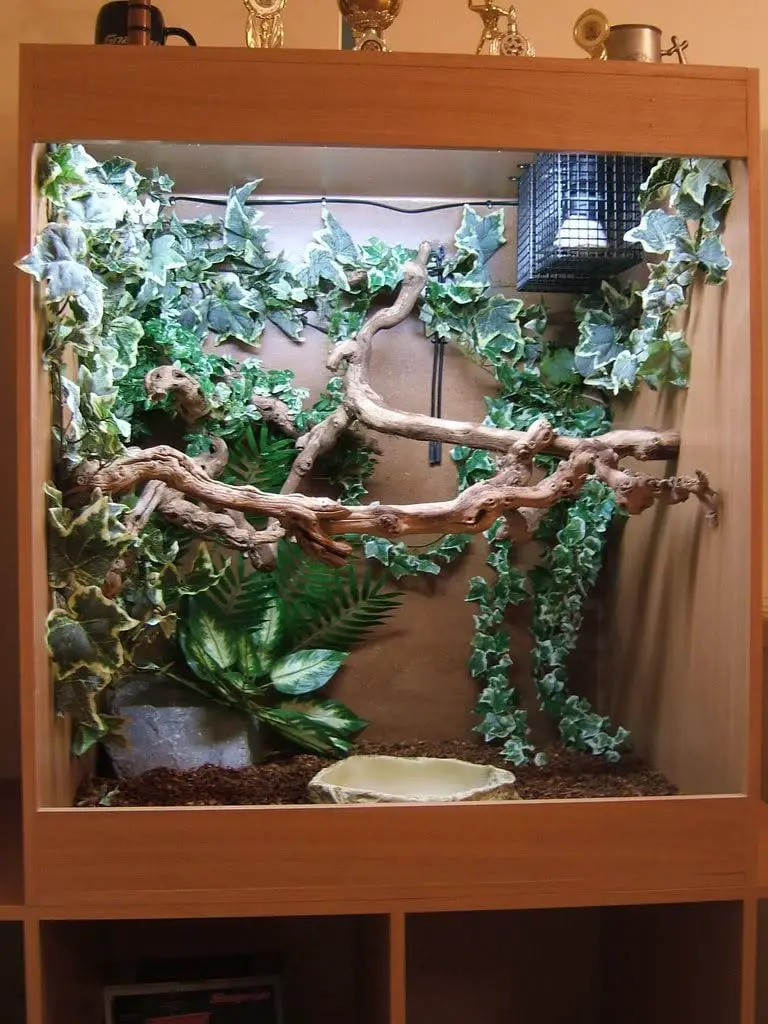
Because Amazon Tree Boas have an arboreal tendency, keepers must be able to provide them with cage decoration. They must have various places towards the vertical space of the cage where the branches form a T because they do not form loops, but they enjoy making a loose set of coils at areas where the branches start to form a T. These tree branches must have about the same size or ½ inch wider than the diameter of the boa, and they must be stable enough to be able to support the entire weight of the snake as it climbs.
Meeting the arboreal needs of Amazon Tree Boas can be an amazing creative venue rather than a burden because this will give the keepers a chance to get innovative by making the colors pop, and it can make their vivarium look as natural as they can. Non-toxic plants can help with the humidity needs of the Amazon Tree Boa while making the vivarium aesthetically pleasing.
Lighting
Like other Amazon Tree Boas, snakes do not need UVB lighting, but installing one in your vivarium can allow live plants to live and grow freely inside. Some experts also think that the presence of the UVB light may have some benefits for the health of your snake.
Lighting schedules can last from 10 hours to 12 hours per day, and these lighting periods can be a breeding stimulant during the winter months when you control how long or how short they are.
Temperature and Humidity
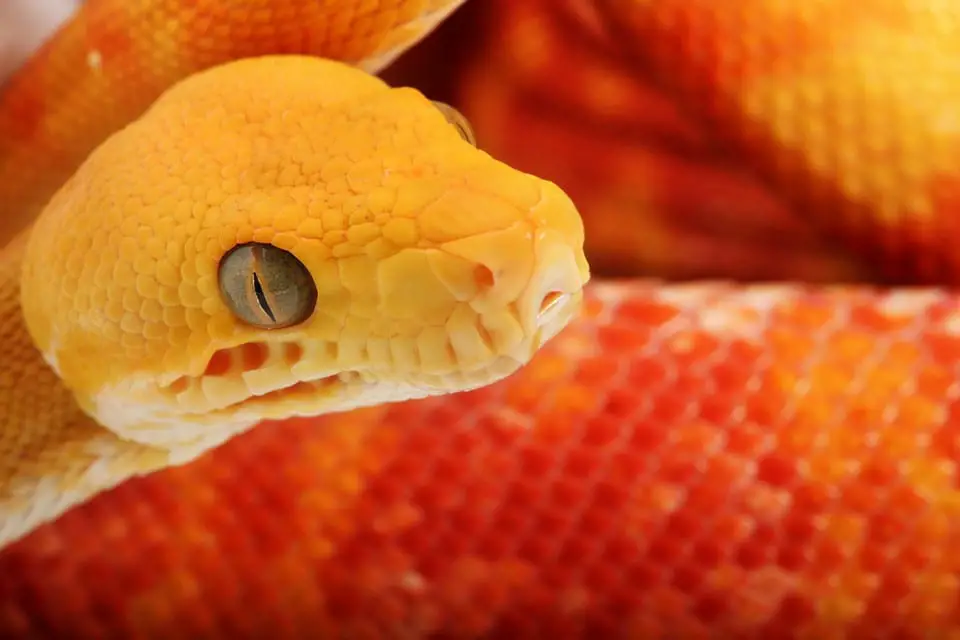
Temperature and humidity are two of the most vital things all snake keepers must never forget as these are essential for a snake’s overall being and survival. The temperature should be taken in two ways inside the vivarium: the first one should be on the ambient heat because these snakes do not spend all of their time on the enclosure floor. Ambient temperature should at least be 77 degrees to 86 degrees Fahrenheit or 25 degrees to 30 degrees Celsius. The second temperature must be taken on the Amazon Tree Boa’s basking spot in the upper reaches of the vivarium. The basking temperature must be about 90 degrees Fahrenheit or 32 degrees Celsius.
The ideal enclosure temperature must be between 82 to 84 degrees Fahrenheit or 28 to 29 degrees Celsius. The nighttime temperature must drop to 75 to 77 degrees Fahrenheit or 24 to 25 degrees during the night.
On the other hand, the Amazon Tree Boa calls for high levels of humidity as this is what they are used to while living in the tropical forests of the Amazon. The perfect levels would be between 60 percent to 80 percent. For keeping the humidity at the right levels, the best action is to mist the cage one to two times a day, depending on your targets and the weather conditions in your area.
As a help in measuring the humidity levels in the cage, a good hydrometer or a digital thermometer is a priceless necessity for the tree boa. This measuring device can warn you immediately as to what might be wrong with the enclosure situation and what you can do about it.
Another thing to consider for the humidity is never to allow standing water to stay toward the bottom of the cage, as high humidity will give mold chances to develop there, and no one would want to get molds in the enclosure.
Cleaning
For keeping the cage clean, it is required to do daily spot cleaning to remove all wet or soiled bedding in the enclosure. Full substrate changes are also required weekly, or as soon as you see them soiled. Observe for mold development, especially in the areas where water bowls are stored.
Fun Facts about the Amazon Tree Boa
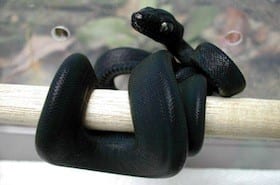
- Amazon Tree Boas are non-venomous snakes, which means that their bites do not have deadly poison with them.
- Recent taxonomical reviews have divided the Amazon Tree Boa into four subspecies: (1) the Amazon Tree Boa, (2) the Central American Tree Boa, (3) the Cook’s Tree Boa, and (4) the Grenadian Tree Boa.
- The Amazon Tree Boas has the largest population among other species of tree boas.
- The females of the species are quite bigger than the males, just like other snakes.
- The Amazon Tree Boas are very colorful and can either be a mix of brown, green, and gray, or a mixture of red, orange, and yellow.
- The Amazon Tree Boas live an arboreal life, which means that they tend to be found in trees and other forms of vegetation, but they also enjoy spending some time on the ground.
- The Amazon Tree Boas are mainly nocturnal, but they sometimes enjoy basking in the sun during the daytime.
- The Amazon Tree Boas also have predators, and they are eagles, tamarins, and humans.
- The Amazon Tree Boas have first been discovered and named in 1758
- Amazon Tree Boas have labial pit organs that have infrared receptors that allow them to sense heat during the night.
Where Can You Get a Pet Amazon Tree Boa?
Being one of the most widely available pet species, Amazon Tree Boas can be found among most exotic pet stores and some pet shop chain branches. You can also opt for getting these beautiful creatures from reputable breeders, whether online or via your locality.
How to Care for a Pet Amazon Tree Boa?
The Amazon Tree Boas that are raised in captivity enjoy roaming around their enclosures, as they are one very active snake species. This is why the cage that should be provided for them must have ample space for the snake to move without making their body uncomfortable.
When they are active, these snakes crawl through trees horizontally, and they occasionally move from branch to branch. They also enjoy spending time up and down the tree trunks. For this reason, owners must be able to provide them with ample space for both horizontal and vertical activities.
Frequently Asked Questions
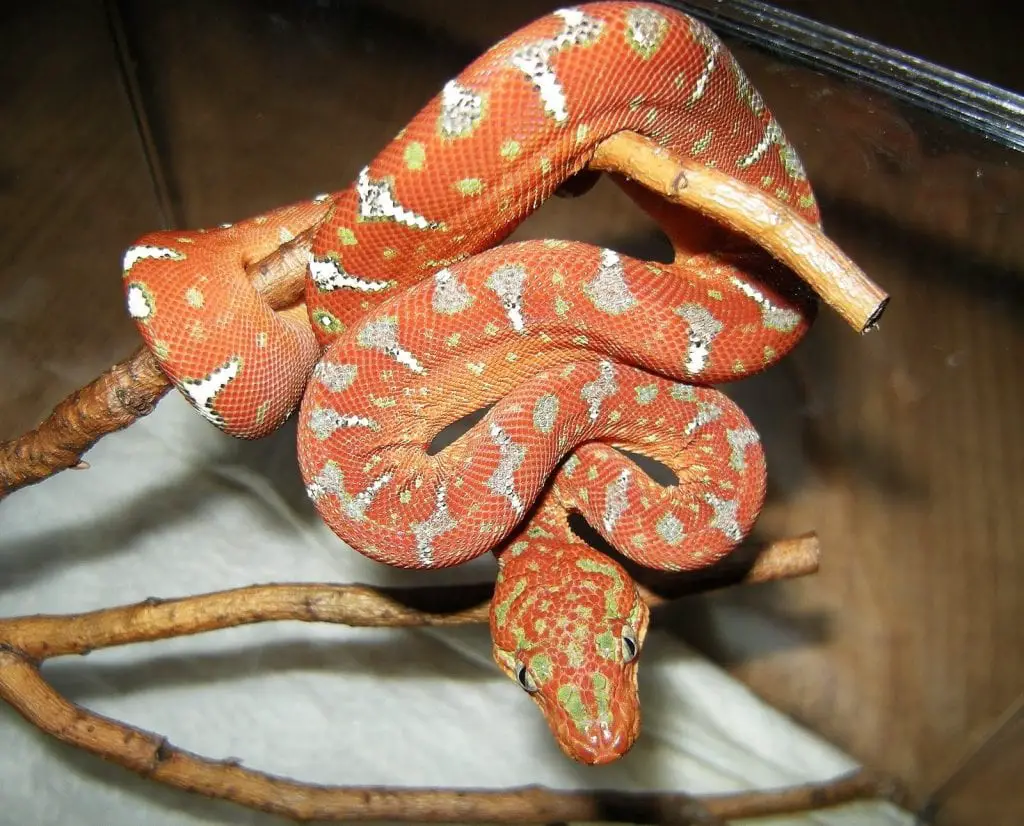
Are Amazon Tree Boas aggressive?
Amazon Tree Boas are known to be extremely aggressive and tend to strike upon and bite when they feel threatened.
How big do Amazon Tree Boas get?
Amazon Tree Boas grow as long as 6 feet and as wide as 2 inches in diameter. They are known for their slender bodies and long tails.
Do Amazon Tree Boas change color?
Amazon Tree Boas do not change their color throughout their lifetime. But, they can either be part of the “colored phase” and the “garden phase.”
What do Amazon Tree Boas eat?
Amazon Tree Boas mainly feed on lizards, birds, frogs, and small arboreal animals. In captivity, they are usually fed with mice and other rodents.
Do Amazon Tree Boas make great pets?
Amazon Tree Boas are preferred by many keepers and breeders, but they might be for everyone because of their famous temperament.
How long does an Amazon Tree Boa live?
Though these have not been observed in the wild, Amazon Tree Boas in captivity can live up to 20 years or even much longer.
Can I handle my pet Amazon Tree Boa?
Like other snakes, Amazon Tree Boas can only be handled for short periods, even when they are tamed and trained. The best way for these pets is just to enjoy them from afar, as they are aggressive individuals.
Are Amazon Tree Boas venomous?
Amazon Tree Boas are non-venomous species that are more active during the night and prefer to spend their time on trees.
Do Amazon Tree Boas have fangs?
Amazon Tree Boas have fangs, but they are not powered by venom to add harm to their bite. Their long fangs are used to take ahold of their prey.
Do Amazon Tree Boas need UVB light?
No, Amazon Tree Boas do not require ultraviolet light to stay healthy.

